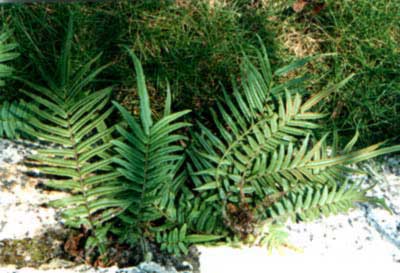China: Planting ferns to improve soil
Chinese scientists have gradually improved the technique of growing ferns (Pteris vittata L.) to 'attract' heavy metal elements in the soil such as arsenic, copper, zinc . With this technique, they hope Hopefully, it can fundamentally solve the problem of heavy metal pollution in downstream areas of China due to the mining process.
In a recent interview, researcher Chen Tong Bin (Chen Dongbin) of the Institute of Geological and Natural Resources Research, under the Chinese Academy of Sciences, said: "They grow plants that can absorb steam." collecting heavier metals than normal as ferns on contaminated soils to attract heavy metals, then they will 'recover' heavy metals from this plant to remove pure metals. making materials for industry.

Planting ferns can improve soil contaminated with heavy metals.
Chen Tong Bin's research team conducted a large-scale renovation for more than 5000 acres of contaminated agricultural land in Hoan Jiang District, Haihu City in Guangxi Province. After each flood, paddy fields and river basins in Guangxi and Yunnan provinces are heavily polluted due to the high concentration of heavy metals coming down from the mining areas, directly affecting production.
According to Chinese authorities, the country currently has nearly 2,000 thousand hectares of cultivated land contaminated with heavy metals, accounting for nearly 20% of the total cultivated land area, with losses of up to 1,000 thousand tons annually. food, directly causing economic losses of more than 10 billion yuan.
Chen Tong Bin's heavy metal soil recovery team began investigating the country's heavy metal pollution since 1997, and in 1999 they discovered a fern - the first plant on The world is known for its ability to attract arsenic.
So far, they have developed 3 intellectual property rights techniques for planting soil restoration plants and assessing soil pollution, they have also found 16 other plants that can also absorb needles. Heavy type on Chinese territory.
The species of ferns distributed widely in southern China, the arsenic content on the leaves of the plant is up to 8 xa, far exceeding the protein content, phosphorus is present on the trunk of the tree but the plant is still growing well. The ability of this plant to absorb arsenic constantly increases with the development of plants, they can also pass this characteristic to the next generation plants.
Currently, the team for the first time uses synchronous radiation technology and environmental scanning electron microscopy to analyze the arsenic resistance mechanism of this plant on the live tree trunk.
The study also found that the fuzzy fibers on ferns have the ability to collect arsenic very specifically, the hairs with water are the main storage of arsenic, it has a distinct effect. very clear for arsenic, so this toxin is 'locked up' in a safe place in the trunk so it does not affect the growth of the plant.
Tuyet Nhung
- Apricot planting techniques
- New plant varieties help improve soil
- Believe it: This small fern can help fight climate change
- Cultivated on the wetlands regained from the sea
- The soil on Mars and the Moon can grow trees
- What is the land? How soil formed?
- Techniques for growing papaya trees are fruitless all year round, with few pests and diseases
- 'Sphere' The withered fern revives when it comes to water
- Study to treat bauxite red mud into planting soil
- Do you have to remove potting covers when planting trees?
- Finding ferns that can live in arsenic-polluted environments
- New fern species in Quang Binh cave
 'Barefoot engineer' invents a pipeless pump
'Barefoot engineer' invents a pipeless pump Process of handling dead pigs due to disease
Process of handling dead pigs due to disease Radiometer
Radiometer Warp Engine: Technology brings us closer to the speed of light
Warp Engine: Technology brings us closer to the speed of light